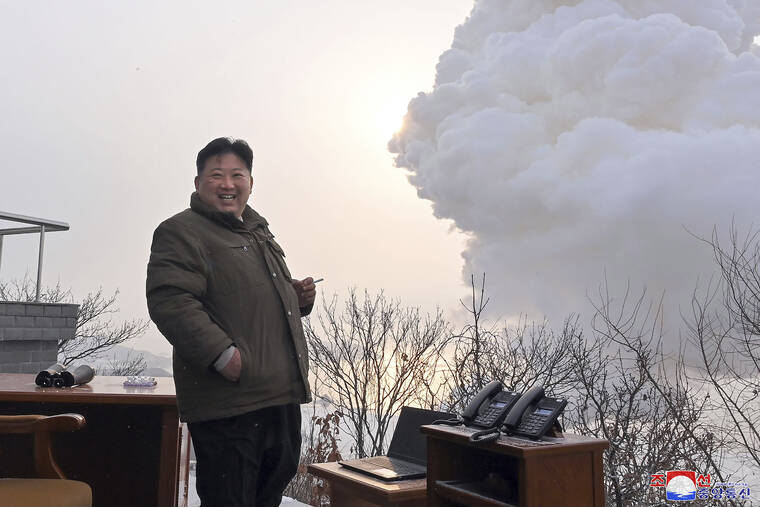North Korea performs key test to build more agile ICBM
SEOUL, South Korea — North Korea has tested a “high-thrust solid-fuel motor” as a key step toward building a new strategic weapons system, state media reported Friday, as the country pushes to develop more agile and powerful intercontinental ballistic missiles designed to strike the U.S. mainland.
North Korean leader Kim Jong Un supervised the successful “static firing test” at the country’s northwest rocket launch facility on Thursday, the official Korean Central News Agency said.
KCNA said the test, the first of its kind in North Korea, carried “strategic significance” as it provided “a sure sci-tech guarantee for the development of another new-type strategic weapon system.” It said Kim expected the new weapon would be built “in the shortest span of time.”
North Korea is likely referring to a solid-fueled ICBM, which is among an array of high-tech weapons systems that Kim vowed to introduce during a major ruling Workers’ Party conference early last year. Other weapons systems Kim promised to manufacture include a multi-warhead missile, underwater-launched nuclear missiles and spy satellites.
The latest motor test showed that North Korea is determined to carry out Kim’s vows to develop such sophisticated weapons systems despite its pandemic-related domestic hardships and U.S.-led international pressures to curb its nuclear program. In recent months, North Korea has test-fired a barrage of nuclear-capable ballistic missiles including last month’s launch of its developmental, longest-range Hwasong-17 ICBM designed to carry multiple warheads.
“We’d been expecting a test of this kind for a while. Large-diameter solid propellant rocket motors will enable North Korea to deploy larger submarine-launched missiles and, more importantly, more survivable and responsive intercontinental-range ballistic missiles,” said Ankit Panda, an expert with the Carnegie Endowment for International Peace.
“Unlike liquid propellant missiles, solid propellant missiles are fueled at the time of manufacture and can thus be released far more quickly in a war, all else being equal,” Panda said. “I wouldn’t be surprised if they’d look to do additional testing and development of these motors before moving to flight-testing.”
The fuel in solid-propellant rockets is already loaded inside, which helps to shorten launch preparation times, increase the weapon’s mobility and make it harder for outsiders to detect what’s happening before liftoff. North Korea already has a growing arsenal of short-range, solid-fueled ballistic missiles targeting key targets in South Korea, including U.S. military bases there.
According to the KCNA report, Thursday’s test was to verify specific technical features of the high-thrust solid-fuel motor based on the thrust vector controlling technology. It said the test results showed all the technical indices proved its reliability and stability.
Joseph Dempsey, research associate for defense and military analysis at the International Institute for Strategic Studies, said it’s difficult to assess the thrust output claimed by North Korea. But he said that “what is potentially significant is the claimed ‘thrust vector controlling technology,’ with imagery suggested gimbaled exhaust nozzle which can redirect the thrust to effectively steer the missile.”
He said that’s a much more advanced method of thrust vectoring than a previous method traditionally used on the North’s solid motor missiles.
“Testing a gimbaled nozzle could therefore represent an important technological waypoint toward North Korea’s stated goal of a solid motor ICBM,” Dempsey said. “However what other technical challenges remain and how far away a flight test of such a system is remains unknown.”

